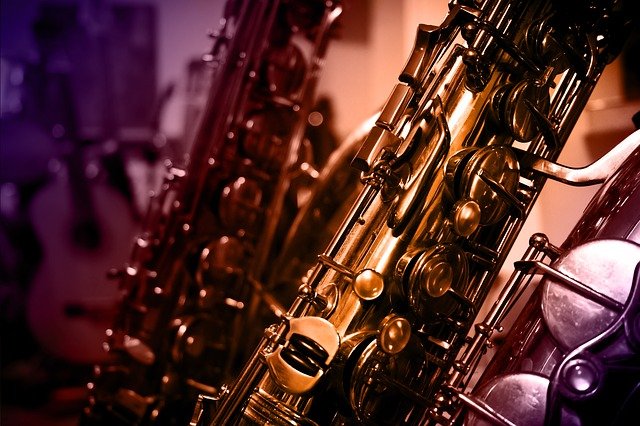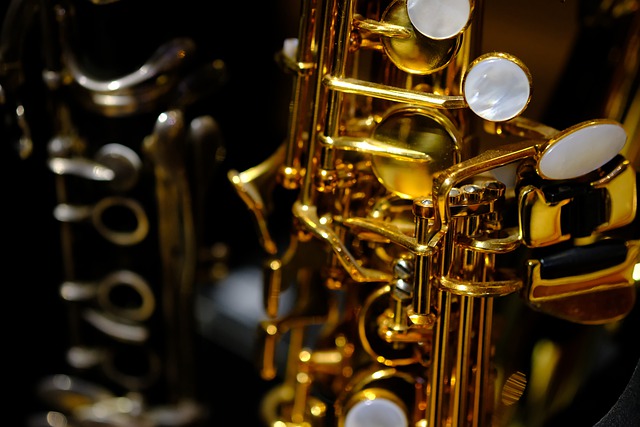What is a Baritone saxophone?
The baritone saxophone or a bari sax as some may call it is a member of the saxophone family of 14 woodwind instruments.
Bari sax is stood in between a higher-pitched tenor saxophone and a lower-pitched bass sax.
The baritone is one of the most common low pitch saxophones in contrast with the bass, contrabass, and sub contrabass saxophones that are rarely used in modern times.
The Baritone saxophone is a single-reed instrument just like its other 13 counterparts and is pitched in E♭ for the most part of the common use.
When by whom and where did the saxophone originate?
The baritone saxophone and all of its family of 14 instruments was invented around 1840-1846 by the Belgium instrument maker Adolphe Sax and was named after the inventor.
When was it first played and who played it?
Gerald Joseph Mulligan, also known as Jeru, an American jazz saxophonist, clarinetist, a composer with its famous “Gerry Mulligan Quartet, Volume 1” is named to be the first introduction to the baritone saxophone as a solo instrument to most.
While bari sax has been played by many musicians at the same timeframe, Gerry Mulligan Quartet is still named a pioneer because of their sound quality and their specific style and melodic performance.
Is baritone saxophone a brass instrument?
The baritone saxophone is considered to be a woodwind instrument.
However, according to some studies and experiences, it has led some of the players to consider the baritone saxophone as an instrument halfway between an instrument belonging to the saxophone family and an instrument belonging to the brass family.
This consideration arose as baritone saxophone playing was compared to the characteristics of its brass counterparts (for ex.: trombone or tuba).
More specifically, it requires more air than other saxophones, and the diaphragmatic thrust required is very similar to that used in brass players.
Who can play baritone saxophone ?
The baritone saxophone is performed by people of various musical talents and skills.
You can be an amateur and play it as a hobby or be a professional and play at an official band.
The bari sax is played by males as well as females.
In most of the developed countries, school-age children can learn the baritone saxophone as part of school music programs and continue to study the instrument in their college as well as earn a PHD in playing bari sax.
What kind of music can you play on a Baritone saxophone?
Bari sax is commonly used in concert bands and chamber music assemblies that mostly play classical music.
It is also played in the military and other types of marching bands that play ceremonial and marching music, including the national anthems and patriotic songs, and big bands that perform jazz.
Bari sax can also be found in other types of ensembles such as rock bands, however, such occasions are quite rare.
Is the Baritone a solo instrument?
As mentioned before, there was a time when Gerald Joseph Mulligan popularised bari sax as a soloist instrument.
However, considering the low tone of the instrument, the role of the baritone saxophone as a soloist instrument has been overlooked as in general a tenor or the alto saxophone tends to hog the spotlight.
Why choose to play the Baritone saxophone
Bari saxophone is not the easiest to play out of the rest of the sax family and it might not be the first instrument to choose to become a soloist.
However, the beauty of the specific low notes can not be disregarded. With its punchy, satisfying tonality the baritone saxophone is capable of adding some of the world’s most unique sounds that mesmerize the listener.
Choosing to play bari sax defines the melody and creates the base structure without which no melody can be assembled to be complete.
Is it easy to play Baritone saxophone?
The baritone saxophone belongs to the saxophone family therefore the study of the technique is exactly the same as the one used for other saxophones, i.e. soprano, alto, tenor, and bass saxophone.
During the learning process, there are no substantial differences regarding the position of the keys on the instrument, the breathing technique, the posture while playing, the use of the mouthpiece and the reed, and the tone in which you play.
The methods of study, for example, are the same as for all other saxophones.
However, playing bari sax, it is a must to have a considerable lung capacity in order to support long phrases, often in sync with other saxophones.
Additionally, while performing, a player must put much effort to position the tongue when hitting the reed as the consequent air displacement takes longer to fill the entire body of the instrument, thus making the baritone more difficult to master than other saxophones.
How much does a Baritone saxophone cost?
The range of the beginner baritone saxophone can vary from $1,500 to $3,000. Intermediate baritones can usually range in cost $2,500 to $4,000 and pro trombones are around $4,000 and up.

Weight and size of the Baritone saxophone
Saxophone Type | Weight (kg) | Weight (lb oz) | Height (cm) | Height (in) |
Baritone | 5.10 kg | 11 lb 2 oz | 76.2 | 30 |
How much to practice Baritone saxophone ?
As the methods of study are the same as for all other saxophones it can be said that the time to learn them is quite similar.
However even if all the saxophones have the same fundamental physical characteristics, the baritone can be considered particular because of its
- Weight, the size of the keys,
- the posture and the position of the hands needed to hold,
- the size of the mouthpiece,
- the reed and the amount of air required for playing.
the technique on baritone saxophone requires a big lung capacity and strength in order to support the instrument.
It also requires a solid embouchure with the mouthpiece.
Considering all this obviously, there is no specific amount of time defined to master bari sax.
But practicing 2-3 hours a day can bring you noticeable improvements and quite good results.


